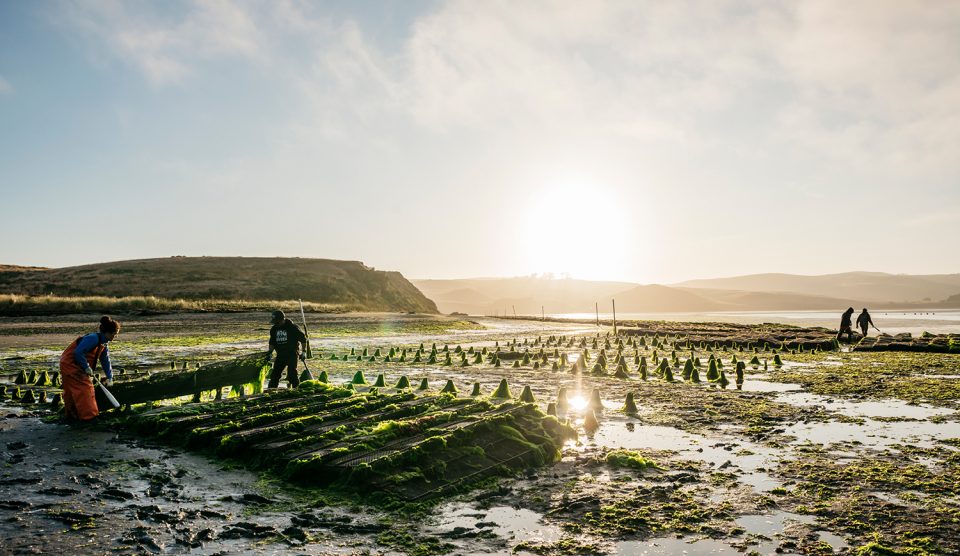Hog Island Oyster Company receives last-minute help from Marin Agricultural Land Trust, the first-ever such easement for mariculture

In the midst of the COVID-19 stress, Hog Island Oyster Company, a shellfish farm in California’s Tomales Bay that produces 5 million oysters, clams and mussels each year, was struggling.
Cofounders John Finger and Terry Sawyer had reduced staff numbers from 300 to 70 and the farm operations needed safety and efficiency improvements the company simply couldn’t afford given the impact of the global pandemic. Things were looking dire until they learned they had been approved for a preservation easement by the Marin Agricultural Land Trust (MALT), which they had applied for three years earlier.
The approval meant an infusion of $1.1 million for Hog Island Oyster Company by a trust that was supporting seafood cultivation for the first time ever.
“Until now our easements have protected just the land. This is the first one that provides for mariculture support,” Thane Kreiner, CEO at MALT, told the Advocate.
Hog Island owns 250 acres of land across from Tomales Bay and by purchasing an easement on the land, MALT prevents other forms of development from occurring there in perpetuity. The land is leased by a grass-fed beef producer and used to house Hog Island’s seed oysters and shellfish farming equipment.
What clinched the deal for MALT was what Kreiner calls Hog Island’s “circular practices.”
“We were really excited about this ranch and the work John and Terry are doing,” he said. “They upcycle oyster shells for calcium inputs, have plans to take seaweed byproduct and use it for human or animal consumption, and filter UV-treated seawater in cold storage tanks, which provides time for any pathogens to be removed. The water from the tanks could then be used to generate artisan salt. It was incredibly exciting to see such a unique property whose owners were paying such close attention to the connection between land and sea, and to connecting outputs from one food production cycle to inputs for another.”
Sawyer admits that Hog Island’s location is its biggest advantage: “It’s very difficult to find locations with good water quality and a land base available to you, because what goes on on the land directly affects what is downstream. So for us to have the water quality we have in Tomales Bay is remarkable.”
Sawyer and Finger are a forward-thinking pair trying to improve their practices in environmentally friendly ways. Shells, shell fragments, sediment and seaweed from the company’s operations are composted and deposited back on the land, while larger shells are stockpiled and used for garden supplements or sold to chicken farmers for calcium carbonate. The composting is important because of the region’s drought, Sawyer said.
It’s very difficult to find locations with good water quality and a land base available to you, because what goes on on the land directly effects what is downstream.
“By spreading the compost, we can improve water conservation and soil fertility,” he explained. Water used for processing is cleaned, filtered and re-used for irrigation.
The company is experimenting with producing red algae that could potentially be used as a supplement in cattle feed, and with harvesting nori, ulva and gracilaria seaweed off the shellfish rafts for consumption, a process that will require hard-to-obtain and expensive permits.
They are also actively involved in research on ocean acidification, restoration of native shellfish populations and the effects of climate change on animals and the watershed.
“We are collaborating with several academic institutions on ocean acidification research including monitoring parameters, developing broodstock and working on other species that may have different responses to changing conditions, including native oysters and seaweed options,” Sawyer said.
“Carbon sinks are a part of that research. We are interested in absorption of carbon, nitrogen and phosphorous, and in using the shells in compost and spreading it on the land to be taken up by grasses. We work with local land use agencies to improve practices on land to reduce sedimentation and nutrient loading, while enhancing water retention on the land to sequester carbon to reduce our impacts on multiple levels.”
The infusion of capital from MALT has been a huge relief to the pair given the stress that the pandemic has incurred.
“The timing of this easement was impeccable, and it allows us to relax a little more and focus our energy on best practices and farming,” Sawyer said. “It will help give us versatility and agility as we move forward and get out of survival mode.”
Follow the Advocate on Twitter @GAA_Advocate
Now that you've finished reading the article ...
… we hope you’ll consider supporting our mission to document the evolution of the global aquaculture industry and share our vast network of contributors’ expansive knowledge every week.
By becoming a Global Seafood Alliance member, you’re ensuring that all of the pre-competitive work we do through member benefits, resources and events can continue. Individual membership costs just $50 a year. GSA individual and corporate members receive complimentary access to a series of GOAL virtual events beginning in April. Join now.
Not a GSA member? Join us.
Author
-

Lauren Kramer
Vancouver-based correspondent Lauren Kramer has written about the seafood industry for the past 15 years.

